Whoa, check that out! The Moon Museum’s on the Tee Vee! Or it will be, June 21st.
The PBS show History Detectives is trying to figure out whether the Moon Museum, a SIM card-sized ceramic wafer created in 1969 by Forrest Myer, with help from an engineer at Bell Labs, which contains drawings by Myer and five other contemporary artists, actually made it to the moon.
The show uses Tampa-based curator/writer Jade Dellinger’s copy of the chip as the hook. They’re making an open plea to viewers with any info on the identity of “John F,” the Grumman engineer supposedly responsible for secretly attaching a chip to the leg of the Apollo 12 lunar landing module.
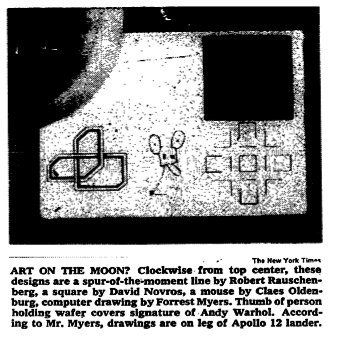
After I posted the NYTimes’ picture of the chip in 2008, it got picked up by Melissa Terras’ Blog, where several people involved in the Moon Museum came forward. The comments now hold a discussion between family members of the Bell Labs engineers who worked on the chips, including Fred Waldhauer, Burt Unger, and Robert Merkle.
Though Myers told PBS that 16 or 20 chips were made, Amy Waldhauer [whose mother Ruth Waldhauer donated the chip to MoMA which was exhibited last year at PS1’s 1969 show], said there were 40.
Also chiming in: curator Annick Berraud, who exhibited a chip in Paris last year, and who is apparently also working on an extended article on the Moon Museum for Leonardo, MIT’s arts journal.
It’s all awesome, but it also sounds like I gotta step up my game if I want to get me a Moon Museum chip. Or at least reopen the comments around here.
Category: art
More Is More: Warhol’s Silver Clouds In Mies’ Crown Hall

Bell Labs’ Billy Kluver guided Andy Warhol to the Mylar balloons the artist used for Silver Clouds, his 1966 installation at Leo Castelli Gallery. And at Ferus Gallery. And at the Cincinnati Arts Center.
At the time, Bell Labs was operating both Project Echo satelloons; after Echo II’s launch in 1964 until Echo I’s disintegration on re-entry into the atmosphere in 1968, these two giant Mylar balloons were visible with the naked eye around the world.
Flash forward to this week, when the Mies van der Rohe Society opened the largest Silver Clouds installation ever, somewhere between “hundreds” of balloons and “1,000” at the Illinois Institute of Technology’s Crown Hall.
At current Armory Show prices, that’s up to $5 million worth of balloons!
ANDY WARHOL’S SILVER CLOUDS FILL S. R. CROWN HALL, through Aug. 1, 2010 [iit.edu via c-monster]
video: Warhol and Mies: Floating Silver Clouds [edwardlifson]
Pour Copie Conforme
After bagging on Blake Gopnik’s comments on Marcel Duchamp playing the buyers of his readymades for fools, I started looking more closely at Duchamp’s actual statements and working process. It’s so easy to consider him as just a source of ideas, and to forget that in fact, he expended a great deal of effort and time on the creation of objects.
On the other hand, that dude would sign just about anything that wasn’t nailed down. Including readymades that were really made, or found, or bought, by others. All over the place. The only thing that stopped him, it seems, was Arturo Schwartz, who insisted Duchamp stop signing stuff to protect the value of the 1964 readymade editions.
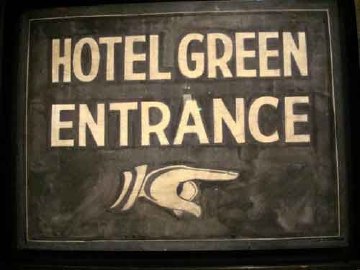
One example: when the late photographer, painter, and avant garde filmmaker Dennis Hopper met Duchamp on the day of the opening of his 1963 retrospective in Pasadena, he grabbed a sign from the Hotel Green, where Duchamp was staying, and asked him to sign it. And he totally did.
Another, from Francis Naumann’s incredible practice history, Marcel Duchamp: The Art of Making Art In The Age Of Mechanical Reproduction, which I picked up at the suggestion of John Powers [Naumann’s gallery was the site of that fantastic Duchamp chess show last year.]:
During the time of the Pasadena exhibition, Duchamp was invited to attend a breakfast in his honor at the home of Betty Asher, an important collector of contemporary art who lived in West Los Angeles. Among the thirty or more guests she invited, one of them, Irving Blum, then owner of the Ferus Gallery in Los Angeles, asked Duchamp if he would consider signing a bottle rack he had found and purchased from a local thrift shop. Just in case the artist agreed, Blum brought the item along with him to the breakfast. When Blum asked, Duchamp responded: “Gladly,” whereupon Blum retrieved the work from the trunk of his car and Duchamp signed it on the bottom rung, adding the usual inscription, “pour copie conforme,” and the date: “1963-14”. When Blum was in the process of returning this treasured artifact to the trunk of his car, Richard Hamilton reportedly rushed out of the Asher house and quipped: “You are, of course, aware of the fact, Mr. Blum, that in order to devalue his work, Duchamp signs everything.” [p.235, emphasis added for the awesome parts]
Indeed, and one of the last things he signed was the replica of Bicycle Wheel which Hamilton had made, and had asked Duchamp to sign the next time he passed through London. [Blum donated his Bottle Rack, below, to the Norton Simon Museum in 1968 after Duchamp’s death.]
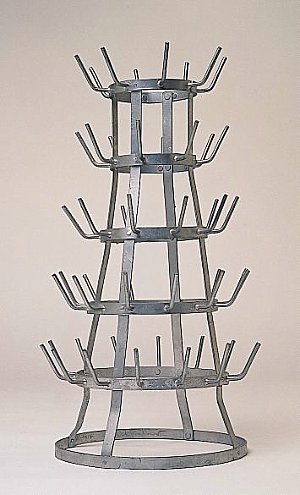
And Pontus Hulten told how Duchamp said the Modernamuseet could save money by making a bunch of readymade replicas for a show instead of shipping them: “Duchamp later signed everything. He loved the idea that an artwork could be repeated. He hated ‘original’ artworks with prices to match.” [p.213]
Which is making me nod and laugh out loud right now as I sit here, with a pile of pens, signing my name over and over and over on the stack of certificates for the edition I’m doing with 20×200.com, which is going to be announced very soon. Stay tuned.
Cue The Dolphin Embassy
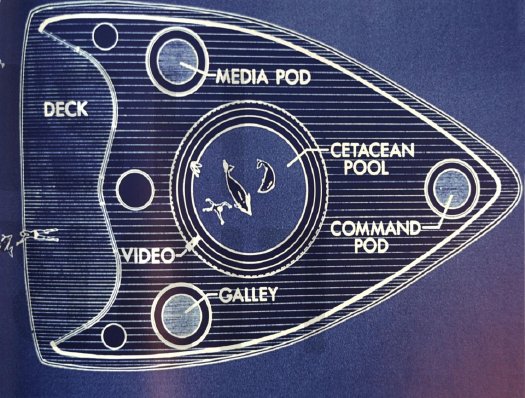
The architecture and art collective Ant Farm first proposed The Dolphin Embassy in Esquire magazine in 1974. When they ended up meeting the owner of the Dolphinarium in Australia a couple of years later, they worked it up into a full-fledged proposal, which got funding from the Rockefeller Foundation and a show at SFMOMA.
Basically, the idea morphed from an underwater building into an open, mobile laboratory craft [above] to facilitate human-dolphin interaction in the wild. [spatial agency has images of both early designs.] First, they would deploy the awesome power of video technology to create a common language with the dolphins. Then…
Here’s Ant Farmer Doug Michels talking about the project with Connie Lewallen in the catalogue for the 2004 retrospective at Berkeley Art Museum:
The next year and a half for me [from 1977-8] was filled with trying to make the Dolphin Embassy real. There was a lot of time spent with both captive and wild dolphins and researching dolphins, a lot of design time on the boat, and a lot of public relations time communicating the dolphin idea to Australia. Putting it in historical context, we were feeling pretty confident about accomplishing things. The House of the Century had been built, Media Burn had been done, The Eternal Frame–these large-scale productions. Cracking the dolphin communication code, well, how hard could that be?! (Laughs.)
CONNIE: Why didn’t the Dolphin Embassy get built?
DOUG: Eventually, it became clear that it was a gigantic project beyond the scale we could accomplish with the funds we had raised. While we didn’t solve cetacean communication during our mission in Australia, the Dolphin Embassy experience provided a deeper view into the mysteries of Delphic civilization.
A few months ago Andrea Grover posted this great 1976 photo of a TV-toting Michels having a diplomatic summit of some kind with his dolphin counterpart. Not sure what they discussed.
From the disbanding of Ant Farm in 1977 up until his unexpected death in 2003, Michels kept developing the Dolphin Embassy concept. By 1987, it was retitled Bluestar, a joint dolphin-human-compatible space colony with a 250-ft diameter sphere of water “ultrasonically stabilized” within a wall of space-made glass. My merely 100-ft satelloon bows in awe at the thought.

Anyway, I’m reminded of all this now because, with the iPad and all, it may be time to dust off those Dolphin Embassy blueprints.
Speak Dolphin press release at Orange Crate Art [mleddy via boingboing]
Doug Michels, Dolphin Lover [andreagrover.com]
The Greatest Camo Story Ever Told
 Sure, there’s Dutch Camo Landscapes, and Razzle Dazzle, and the Civilian Camouflage Council, but it all pales in comparison to the truly epic WWII camo accomplishments of Jasper Maskelyne and The Magic Gang.
Sure, there’s Dutch Camo Landscapes, and Razzle Dazzle, and the Civilian Camouflage Council, but it all pales in comparison to the truly epic WWII camo accomplishments of Jasper Maskelyne and The Magic Gang.
Maskelyne was a British magician-turned-Army camo mastermind who, in 1941, led a ragtag band of desert artists and illusionists who created a series of incredible camo techniques that protected Allied forces in North Africa from aerial reconnaissance and bombardment.
Using burlap and sticks, they disguised trucks as tanks, and tanks as trucks, and they created devices to enable tanks to cover their own tracks across the desert sands. But the most amazing achievements are in his 1949 memoirs, Magic – Top Secret where Maskelyne–whose grandfather, also a magician, invented the pay toilet–tells how he saved the port of Alexandria, Egypt from night bombing by building an elaborately lit decoy port, several miles away in the desert. Using incendiary devices and real anti-aircraft artillery, he and his Magic Gang fooled the German bombers with realistic-looking “hits” and return fire; and by morning, his crews would strew papier-mache rubble around the real port, giving simulated damage for the reconn pilots to report back. [below: a German spy photo of part of the port]
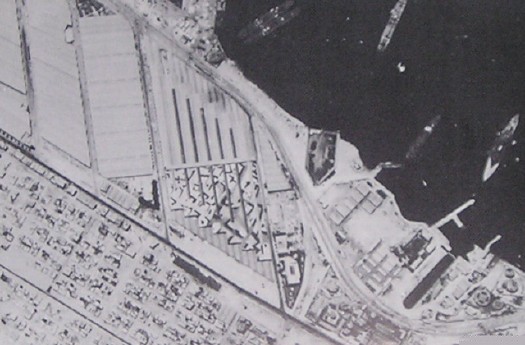
The success of the Alexandria decoy was only surpassed by Maskelyne’s brilliant [literally] strategy for protecting a vital supply route for the Allies, the Suez Canal. He designed “Dazzle Lights,” a rotating structure of made up of mirrors and 24 powerful anti-aircraft searchlights that, when set into motion, gave off a “Whirling Spray,”:
[Maskelyne] managed to create beams nine miles long, twenty-four of them from each searchlights [sic] … the magic mirrors were a success, and the next job was to get the device into mass production. With them, we made twenty-one searchlights serve for the entire one-hundred-mile length of the Suez Canal.
That’s right, the Suez Canal was saved from being bombed by the biggest lightshow in history: the 100-mile-long, Whirling Spray of almost two dozen Dazzle Lights.
How is it possible that I did not know this before now? Why is this miracle of modern warfare not taught in our military academies? Our elementary schools, even? How are these mindblowing aesthetic achievements not celebrated as a landmark in the history of art? Why is there no Bruckheimer movie, starring Josh Hartnett as the daring soldier magician? Maybe because the entire thing is bullshit.
In 2004, military historian and magician [seriously] Richard Stokes published the findings of his multi-year investigation into Maskelyne’s claims. They are gathered in the exhaustively paged website, MaskelyneMagic.com. Working with the magician’s son, he had access to Maskelyne’s archives and scrapbooks from the war. Stokes also cross-referenced official records, declassified intelligence reports, and consulted experts and historians in the North African war. And there is nothing in the historical record to support Maskelyne’s fantastical claims.
On Alexandria, the place where he said he built a decoy port doesn’t even exist; neither does the geography he describe match to any in the vicinity of the city. There are no pictures or corroborating eyewitness accounts, and no documentation.
On the Suez front, Stokes demolishes Maskelyne’s claim to have invented Dazzle Lights by pointing to similar, tank-based tactics under development since WWI. Again, no record of Dazzle Lights can be found in the historical source material, and extensive accounts of the actual defense of the Canal provide well-documented alternative explanations to Maskelyne’s. According to Stokes, Maskelyne didn’t actually come up with the Whirling Spray idea until 1942, after the aerial threat had subsided. And he quotes the illusionist’s son: “The ‘Dazzle Lights’ were an idea which was, I believe, constructed only in one prototype and tested on one occasion.”
Which appears to be the scene depicted in the photo gallery on Stokes’ site, where a searchlight is being outfitted with a faceted, mirrored cone extension:

Which means the photo below, showing an awesomely Duchampian folly, 18 flashlights on a turntable, is somewhat confusing to me:
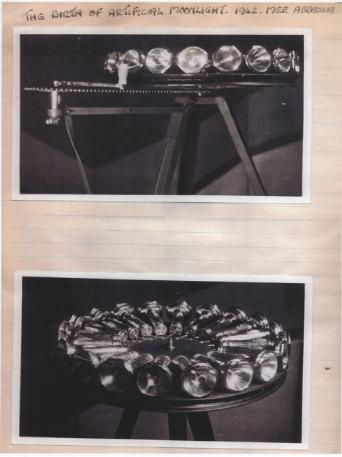
But with a caption like, “The birth of artificial moonlight, 1942,” I’d think that Maskelyne’s imagined heroics are long overdue for [re-]creation.
The War Magician| “”Myth is invulnerable to mere facts” – Barthes [all images via MaskelyneMagic.com]
Previously: Bombardment Periphery, Rotterdam, and Los Angeles’s ‘wigwam’ of searchlights; Forrest Myers’ light pyramid
The Togs Must Be Crazy

Colorful, cheap African textiles: they’re not just for Yinka Shonibare anymore!
Called Pagne in West Africa and Kanga [also khanga] in Tanzania, 1×1.5m screenprinted cotton wraps are produced all across Africa. There is a tradition to make commemorative kanga for major events, such as the official visit or inauguration of a US president.

Or more typically, the inauguration of a local political leader. Politicians in newly independent nations quickly adapted a traditional practice, and distributed the government-produced fabric for free or at a subsidized cost to their supporters.
As Linda reports in full-color glory on All My Eyes, the Tropen Museum in Amsterdam has a show, “Long Live The President | Portrait Cloths from Africa,” which includes over 100 examples of these textiles. Many come from the extensive private collection of Bernard Collet and can be seen online. The Tropen show runs through August 29th. Obviously, everyone should go.
Even more obviously, though, everyone should be commissioning Pagne and Kanga designers to make commemorative patterns for whatever event or non-event they want to propagandize, too. The mind reels at the awesome possibilities.
African Portrait Cloth [all my eyes]
Long Live The President | Portrait Cloths from Africa [tropenmuseum.nl via all my eyes]
Adire African Textiles [adireafricantextiles.com via a.m.e., like basically everything in this post]
Nouveau manuel complet du fabricant et de l’amateur de photos
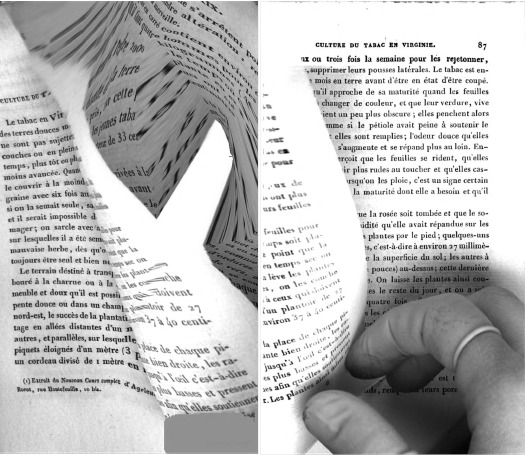
So fantastic. I stumbled across this inadvertent diptych in Google Books, it’s pp. 86-7 of P. Ch. Joubert’s 1844 addition to the Manuels Roret series, Nouveau manuel complet du fabricant et de l’amateur de tabac.
It’s beautiful, somewhere between the process-heavy, content-free abstraction of Walead Beshty and the reverential physical investigations of Abelardo Morell, with a bit of those weird Weegee funhouse mirror photos thrown in for good measure.
And yet they’re also entirely of their own time, place, and making.
A few years ago at John Connelly, my buddies Jonah Freeman and Michael Phelan showed some sweet prints of crumpled aluminum foil shot on a flatbed scanner. [Mitterand+Sanz has images] Which could be a great process here. But I’d really love to figure out how to create negatives from these scans and make up some big, old school silver gelatin prints. [thanks GF-R for the heads up on Morell]
Related from last October: Why is Google giving us the finger? [designobserver.com]
Google Image collection of Google Books Finger [via BoingBoing]
‘Cieli ad alta quota’ by Alighiero e Boetti

Hans Ulrich Obrist, is there anything you haven’t done? In 1993 as part of the Museum In Progress project, Obrist helped the Italian conceptual artist Alighiero e Boetti realize a longtime idea of putting art on airplanes.
In addition to double-page spreads in their in-flight magazine, Austrian Airlines made six seatback tray-sized puzzles available of Boetti’s drawing series, Cieli ad alta quota (High in the Sky).
If any puzzles survived to be collected or traded, they’re not generating the typical online info flotsam. Maybe in this case, it should be jetsam.
Museum in Progress On Board [mip.at]
Everyone’s An Artist
Artist/curator Anton Vidokle reworks an excellent lecture on the problems of curator/artists in the latest issue of e-flux journal
I feel that whereas artists’ engagement with a range of social forms and practices not normally considered part of the vocabulary of art serves to open up the space of art and grant it increased agency, curatorial and institutional attempts to recontextualize their own activities as artistic–or generalize art into a form of cultural production–has the opposite effect: they shrink the space of art and reduce the agency of artists.
Curators claiming the mantle of art for their shows is an issue at least as old as the 1960s, but it has been exacerbated, Anton says, by the demise of the critic’s power. All in all, a sharp read. [via afc]
Related: Gregory Battcock and ‘The Essential Triad’
Pixel Art Minidoc By Simon Cottee
This 11-minute documentary short by Brisbane animator Simon Cottee gives a nice look at contemporary pixel art and its origins.
Unsurprisingly, game developer Jason Rohrer has the most thoughtful perspective on the idealized, ex-post-facto perception of pixels as these perfect, hard-edged squares, which he attributes in part to looking back at old low-res games on new, hi-res monitors.
Cottee et al make the connection between pixels and pointillism, but the focus on animation leaves out the influence both pixel-centric image software, like Photoshop, and pixel-related art shown in galleries. [Juan Cespedes, Cory Arcangel, Sherrie Levine, Joerg Colberg or Thomas Ruff, or even Tauba Auerbach or Gerhard Richter] Still well worth a view.
Slow Cinema vs. Art Cinema
On the occasion of Apichatpong Weerasethakul [1] winning the Palme d’Or, Frieze‘s Dan Fox has a incisive recap of the debate over Slow Cinema that erupted after Nick James’ Sight and Sound recent op-ed calling the genre out as a passive-aggressive dare to the audience to admit they’re bored.
The row among film critics and festivalgoers is as annoyingly insidery and lingo-obsessed as any art world argument. [Fox is careful to give equal time to competing terminologies. One blogger critic, Harry Tuttle, thinks Slow Cinema is pejorative, and proffers Contemporary Contemplative Cinema instead, which seems arbitrary. Might as well call it Minimalist Meditative Movies.]
Fox’s dead-on point is how insulated and blind these two systems of production and distribution–theater/festival/DVD vs gallery/installation/edition–are from each other. And this, despite the remarkable confluence of interests, strategies, and styles among filmmakers and artists on both sides of the divide:
Much as I admire Tuttle’s spirited engagement with his favoured genre of contemporary cinema, nowhere on his timeline of CCC/Slow Cinema is there anything that represents, for instance, the achievements of Structural cinema. This is curious, for if ‘plotlessness’, ‘wordlessness’, ‘slowness’ and ‘alienation’ are what he is trying to chronicle, where are Andy Warhol’s Empire, from 1964, or Michael Snow’s 1967 film Wavelength for example? Nor is there any acknowledgement of how these multiple strands of experimental cinema history have fed into the work of artists today.
Artists such as Tacita Dean, Sharon Lockhart, and Matthew Barney, for example. [On the other side of the fence, I’m not sure why no one seems to have mentioned my own personal favorite Slow Cineman, Gus Van Sant, who emptied Sundance theaters with Gerry and whose lingering, looming Elephant also won at Cannes.]
Barney has broken theatrical and festival ground with his Cremaster Cycle, of course. But I think Frieze, which has commissioned projects from Weerasethakul, has high hopes for him as a candidate for bringing the worlds of these two film traditions together. We’ll see.
Slow, Fast and Inbetween [frieze]
[1] yes, he’s in the art world pronunciation guide.
Slate-Roofed Houses
A couple of months ago, I wondered aloud about the reason Yves Klein schlepped all the way out to the Parisian suburbs to make the leap into the void for his famous photocollage, Leap into the Void.
The site, 3, Rue Gentil Bernard, Fontenay-Aux-Roses, has changed since October 1960, but it houses a church dedicated to Sainte Rita, with whom Klein had a spiritual connection. [A votive offering assemblage Klein made during one of his pilgrimages to St. Rita’s monastery in Italy is in the Hirshhorn’s just-opened retrospective.]
As it turns out, I should’ve just been reading my Art News instead. Kim Levin wrote about Leap Into The Void in the March 2010 issue, and reports that it wasn’t Catholic mysticism, but Klein’s other passion, judo, that drew him to Fontenay-Aux-Roses.
She cites the 2006 obituary for photographer Harry Shunk who, with his assistant Janos Kender, shot Klein as he “climbed to the top of a wall and dived off it a dozen times–onto a pile of mats assembled by the members of his judo school across the road.”
But wait, is it the judo school or the pile of mats that was across the road? After a bit more searching, I found this intro to a 2006 monograph, L’envol d’Yves Klein: L’origine d’une legende, which basically puts Fontenay at the center of Klein’s story. [It might help that it was written by a couple of Fontenaysiens, Terhi Génévrier-Tausti and Pierre Descargues.] Anyway, Klein was raised there, and his friend had the Olympic Judo Club there. So yeah.
The best part of Levin’s story, though, comes from Michelle White, who curated “Leaps into the Void: Documents of Nouveau Réalist Performance,” at the Menil:
after she discovered an odd object in the Menil archives: a piece of slate. It wasn’t art–just a piece of slate “collected” by Dominique de Menil in 1981 from the mansard roof that Klein presumably leaped from.
The Matteses would be so proud.
White’s show includes other photos from the Leap, including this spectacular action detail, which are in the Menil’s holdings:
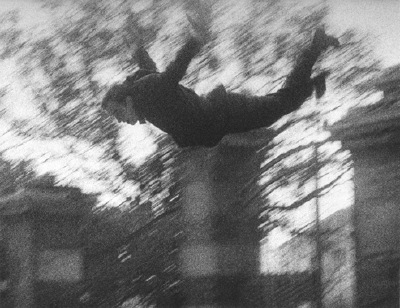
Looks like someone’s gotta book a trip to Houston.
Yves Klein’s Leap Year [artnews via @johnperrault, yes, he’s on twitter now]
Leaps into the Void: Documents of Nouveau Realist Performance, through August, 8, 2010 [menil.org]
Oh My Heck, Spiral Jetty India Pale Ale
That is so Epic.

From Epic Brewing Company, Salt Lake City, Utah.
Spiral Jetty IPA | Epic Brewing Company [epicbrewing.com via the freshly relocated tyler green]
Related? The Shoppes at Rozel Point, from Visiting Artist (sic), a lecture involving Smithson which I gave at the University of Utah:

Of All The Satelloon Photos I’ve Loved Before
A digitized collection of vintage NASA Goddard Space Flight Center newsletters led me to the June 23, 1963 issue of LIFE Magazine. If it were possible for any photo of a Project Echo satelloon to be slightly less than awesome, this photo would move forward to be the awesomest:
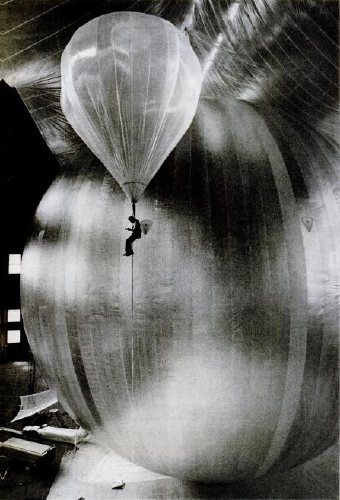
It’s a technician inspecting for leaks during a test inflation of the Echo II at Lakehurst, New Jersey, which was long the Navy’s site for giant inflatable vehicles. From the 1930s construction photos of the massive dirigible hangars to the parades of Navy blimps during WWII, the “Lakehurst” is a stealth candidate for awesomest single search term Google’s LIFE Magazine image archive. Unfortunately, this photo is not included. I’d love to find it, though; someone deserves a credit.
Here’s one of the same test, only there’s no location, and it’s misdated. credit: NASA. And it’s public domain. Here’s one of the first ever photos of an Echo satelloon; famous LIFE photojournalist Grey Villet took it while standing next to the antenna used to bounce the first radio signal off Echo I in 1960.
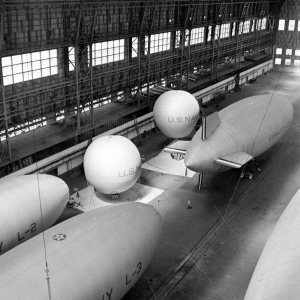
All of this is related to my master plan to show a satelloon as an art object, sure, but it’s also precipitated by NASA’s latest, the Bullet 580, dubbed, depressingly, “the world’s largest inflatable airship,” which was test inflated last weekend. At 235 feet long and 65 feet across, it practically fills the Garrett Coliseum in Montgomery, Alabama [below]
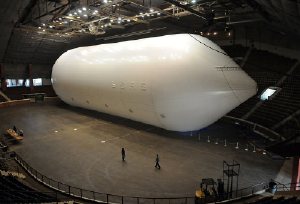
If there were a clearer sign that Our Nation has lost its way in the field of Giant Balloons And The Buildings That Hold Them, I can’t think of it. A sad, sad day. [images: George Strock/LIFE; AP]
‘No Artists Were Paid In The Making Of This Commercial’

The ad’s been running for a while now, but Jean just spotted this disclaimer at the end of AT&T’s “Blanket” commercial last night: “The artists Christo and Jeanne-Claude have no direct or indirect affiliation or involvement with AT&T.”
I will assume they tried to contact Christo by calling him on his iPhone, but they got cut off.
AT&T Rethink Possible – Blanket Commercial [search youtube if the link is broken]
Previously: The Gates Bill
